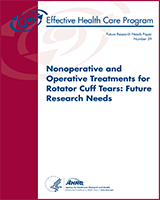This publication is provided for historical reference only and the information may be out of date.
Nonoperative and Operative Treatments for Rotator Cuff Tears: Future Research Needs
Future Research Needs Papers, No. 39
Authors
Investigators: Mary Butler, PhD, MBA, Mary Forte, PhD, DC, Jon Braman, MD, Marc Swiontkowski, MD, and Robert L Kane, MD.Affiliations
Excerpt
The systematic literature review, Comparative Effectiveness of Nonoperative and Operative Treatments for Rotator Cuff Tears, was conducted by the University of Alberta Evidence-based Practice Center (EPC) in 2010 to examine the effectiveness of various nonoperative and operative treatments for adults with partial- or full-thickness rotator cuff tears. The review addressed six Key Questions (KQs) that compared patient outcomes after various operative approaches and techniques, early versus late surgical repair, operative versus nonoperative treatment and between various nonoperative therapies. The outcomes included health-related quality of life, return to work, pain, shoulder function, rotator cuff integrity, and complications. However, adverse treatment effects and the impact of baseline patient and injury characteristics on outcomes were also included.
The systematic review was unable to fully answer the KQs using the rotator cuff literature from 1990 through August 2009 because the literature was sparse and of low to moderate quality. Of the 137 studies included, less than one-fifth were clinical trials and more than half were uncontrolled studies. The literature limitations included low study quality, disparate treatments and outcomes, small sample sizes, incomplete followup, and a heavy focus on surgical technique or approach research over other aspects of rotator cuff treatment (82 percent of studies). The randomized clinical trial (RCT) literature was of particularly low quality with high risk of bias from the manner in which the studies had been conducted. The observational study literature was of moderate quality but often lacked control for the effects of potential confounding factors on outcomes.
For most rotator cuff interventions, only sparse data were available, which precluded firm conclusions about the value of any single approach in the optimal management of rotator cuff tears. Although most interventions showed positive effects, few improvements were of clinical importance. The paucity of evidence on early versus delayed surgery (one trial) was a noted concern because of the lack of evidence available for providers and patients on the important choice of initial nonoperative management or immediate surgical repair.
The review concluded that more research and higher quality research are needed to determine the relative effectiveness of rotator cuff treatments.
This Future Research Needs follow-on project used stakeholder feedback to identify and prioritize the current research knowledge gaps in rotator cuff treatment in order to improve outcomes after rotator cuff tears. The focus of this project was on treatment and post-treatment outcomes rather than complications, because the systematic review found that rotator cuff treatment complications were infrequent and often not clinically important.
Prepared for: Agency for Healthcare Research and Quality, U.S. Department of Health and Human Services1, Contract No. 290-2007-10064-I, Prepared by: Minnesota Evidence-based Practice Center, Minneapolis, MN
Suggested citation:
Butler M, Forte M, Braman J, Swiontkowski M, Kane RL. Nonoperative and Operative Treatments for Rotator Cuff Tears: Future Research Needs. Future Research Needs Paper No. 39. (Prepared by the Minnesota Evidence-based Practice Center under Contract No. 290-2007-10064-I.) AHRQ Publication No. 13-EHC050-EF. Rockville, MD: Agency for Healthcare Research and Quality. February 2013. www.effectivehealthcare.ahrq.gov/reports.final.cfm.
This report is based on research conducted by the Minnesota Evidence-based Practice Center (EPC) under contract to the Agency for Healthcare Research and Quality (AHRQ), Rockville, MD (Contract No. 290-2007-10064-I). The findings and conclusions in this document are those of the author(s), who are responsible for its contents; the findings and conclusions do not necessarily represent the views of AHRQ. Therefore, no statement in this report should be construed as an official position of AHRQ or of the U.S. Department of Health and Human Services.
The information in this report is intended to help health care researchers and funders of research make well-informed decisions in designing and funding research and thereby improve the quality of health care services. This report is not intended to be a substitute for the application of scientific judgment. Anyone who makes decisions concerning the provision of clinical care should consider this report in the same way as any medical research and in conjunction with all other pertinent information, i.e., in the context of available resources and circumstances.
None of the investigators have any affiliation or financial involvement that conflicts with the material presented in this report.
- 1
540 Gaither Road, Rockville, MD 20850; www
.ahrq.gov
